
Straight Lines Class 11 continues the study of coordinate geometry, which the students have studied in the previous chapters. Coordinate geometry is a combination of algebra and geometry. In this chapter, the students will study the properties of the simplest geometric figure – the straight line. Straight Lines Class 11 Solutions explain that in a triangle ABC, if the area is zero, then the three points A, B, and C lie on the same line. The straight line is important in geometry as it is part of our daily lives in various ways.
Class 11 straight lines cover the slope of a line, the distance of a point from a line, and various forms of the equation of a line. The solutions are well-written by the experts and provide in-depth explanations of the concept. The students get the solutions to all the questions of this chapter in the NCERT book. The Straight Lines Class 11 NCERT solutions are ideal for the CBSE Board and other competitive exam preparation.
If students are looking for solved examples, important topics, and Class 11 Maths NCERT notes of all the chapters, they can get them here.
- Snapshot of NCERT Solutions for Class 11 Maths Chapter 9: Straight Lines
- Class 11 Math Straight Lines: Key Topics, Weightage
- Important Formulas of Straight Lines Class 11
- Class 11 Maths Straight Lines Chapter – NCERT Solutions PDF
- Class 11 Maths Straight Lines Exercise-wise Solution(Old NCERT)
- Class 11 Maths Straight Lines Exercise 9.1 Solutions
Snapshot of NCERT Solutions for Class 11 Maths Chapter 9: Straight Lines
Here is a quick overview of the Straight Lines Class 11 NCERT:
- Straight Lines Class 11 Solutions cover the concept of slope. It says that the slope (m) of a non-vertical line passing through the points (x1, y1) and (x2, y2) is given by -
- When a line makes an angle with the x-axis, then the slope (m) of the line is given by -
- The slope of a vertical line is undefined, and that of a horizontal line is zero.
- For a line L1 and L2, with slopes m1, and m2, the acute angle is given by -
- Two lines are parallel only when their slopes are equal, and they are perpendicular if and only if the product of their slopes is -1.
- The condition for three points A, B, and C to be collinear is if the slope of AB = the slope of BC.
- There are more such conditions and formulas covered in the Straight Lines Class 11 NCERT.
For a comprehensive NCERT solution of Class 11 and Class 12 of Physics, Chemistry & Maths, check here.
Class 11 Math Straight Lines: Key Topics, Weightage
While preparing for the Straight Lines Class 11, students must focus on understanding straight lines to master other topics in coordinate geometry and beyond. In the entrance exams, questions are twisted; hence, it is advisable to practice a variety of problems. The following are the topics covered in this chapter:
| Exercise | Topics Covered |
|---|---|
| 9.1 | Introduction |
| 9.2 | Slope of a Line |
| 9.3 | Various Forms of the Equation of a Line |
| 9.4 | Distance of a Point From a Line |
Straight Lines Class 11 Weightage in JEE Mains
| Exam | Number of Questions | Weightage |
|---|---|---|
| JEE Mains | one to two questions | 6.6% |
Important Formulas of Straight Lines Class 11
Important Formulae of Straight Line for CBSE and Competitive Exams
- Various Forms of Line Equations –
- Slope-intercept form:
- Point-slope form:
- Two-point form:
- Intercept form:
- Normal form:
- Slope-intercept form:
- Slope of a Line:
- Angle Between Two Lines:
- Distance of a Point
from a Line
- Distance Between Two Parallel Lines and :
Class 11 Maths Straight Lines Chapter – NCERT Solutions PDF
A free Straight Lines Class 11 PDF is available here. The students must download it and prepare for their exams. The PDF will help them get the concept clarity, and hence they will be able to score high in their exams.
Chapter 9 Straight Lines Class 11 NCERT Solutions: Free PDF Download
More Links
| NCERT Class 11 Notes | NCERT Notes for Class 11 & 12 | NCERT Solutions for Class 11 Maths |
Class 11 Maths Straight Lines Exercise-wise Solution(Old NCERT)
Class 11 Maths Straight Lines is numbered as Chapter 9 as per the latest syllabus given by CBSE. Students will find the old NCERT solutions exercise-wise below. Class 11 chapter 10 straight lines is divided on three exercises and a miscellaneous exercise which summarises all the concepts covered in the chapter. Class 11 Straight Lines Ex 10.1 focuses on basic concepts such as the equation of a line, the slope of a given straight line, and related concepts. Class 11 Ex 10.2 focuses on important concepts related to the equation of a line in different forms. Exercise 10.3 deals with more advanced concepts such as parallel and perpendicular lines and related equation forms. Students can find complete solution of all exercise below;
Class 11 Maths Straight Lines Exercise 9.1 Solutions
Class 11 Maths Straight Lines Exercise 9.1 focuses on basic concepts such as the equation of a line, the slope of a given straight line, and the slope of a line when two points and a line are given, finding parallel and perpendicular of a given line. Students must understand these topics to form a strong basic understanding of coordinate geometry. Ex 9.1 class 11 of NCERT Mathematics consists of 14 questions and students will find the solution of all the questions below.
Class 11 Straight Lines Exercise 9.1 SolutionsQ1. Draw a quadrilateral in the Cartesian plane, whose vertices are (– 4, 5), (0, 7), (5, – 5) and (– 4, –2). Also, find its area. |
| A.1. Let the given points be A(–4, 5), B(0, 7), C(5, –5) and D(–4, –2). Then quadrilated ABCD can be plotted on the graph by joining the points A, B, C and D. We connect diagonal AC such that area (ABCD) = (ΔABC) + (ΔADC) Now,
Similarly,
Hence, area (ABCD) =
|
| Q2. The base of an equilateral triangle with side 2a lies along the y-axis such that the mid-point of the base is at the origin. Find vertices of the triangle. |
| A.2. Let ABC be the equilateral triangle of side 2a and 0 be the origin. Then AB = BC = AC = 2a O is the mid-point of AB we have AO = a BO = a We know that A and B lies on y-axis so they have co-ordinate of the form (0, y). Hence, co-ordinate of A is (0, a) and that of B is (0, –a) Since OC, bisects AB at right angle, by Pythagoras theorem, AC2= OA2 + OC2
And as C we on x-axis it has co-ordinate of the form (x, 0) |
| Q3. Find the distance between P (x1, y1) and Q (x2, y2) when : (i) PQ is parallel to the y-axis, (ii) PQ is parallel to the x-axis.
|
|
|
| Q4. Find a point on the x-axis, which is equidistant from the points (7, 6) and (3, 4). |
| A.4. Let A(x, 0) be the point on x-axis when is equidistant from P(7, 6) and Q(3, 4) Then, PA = QA Squaring both sides, we get,
The required point on x-axis is |
Commonly asked questions
20. Intersecting the y-axis at a distance of 2 units above the origin and making an angle of 30o with positive direction of the x-axis.
20.
The slope of the line is m = tan 30° =
And x-intercept, c = 2
Using slope intercept form, equation of line is
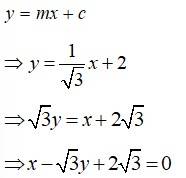
73. Find equation of the line which is equidistant from parallel lines 9x + 6y – 7 = 0 and 3x + 2y + 6 = 0.
73. The given eqn of limes are.
9x + 6y – 7 = 0 ______ (1)
3x + 2y + b = 0 ______ (2)
Let P (x0, y0) be a point equidistant from (1) and (2) so
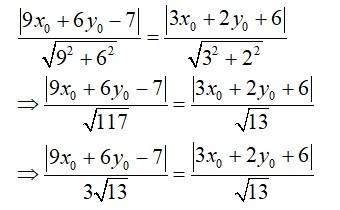
9x0 + 6y - 7 = ± 3 (3x0 + 2y0 + 6)
When, 9x0 + 6y0 – 7 = 3 (3x0 + 2y0 + 6)
⇒ 9x0 + 6y0 - 7 = 9x0 + 6y0 + 18
⇒ - 7 = 18 which in not true
So, 9x0 + 6y0 - 7 = -3 (3x0 + 2y0 + 6)
⇒ 9x0 + 6y0 -7 = -9x0 -6y0 -18
⇒ 18x0 + 12y0 + 11= 0.
Hence, the required eqn of line through (x0, y0) & equidistant from parallel line 9x + 6y - 7 = 0
and 3x + 2y + 6 = 0 is 18x + 12y + 11 = 0.
74. A ray of light passing through the point (1, 2) reflects on the x-axis at point A and the reflected ray passes through the point (5, 3). Find the coordinates of A.
Let A have the co-ordinate (x, o)
By laws of reflection
∠PAB = ∠ QAB = θ
And ∠ CAQ + θ = 90°
As normal is ⊥ to surface (x-axis)
⇒ ∠CAQ = 90° - θ
and ∠CAP = 90° + θ


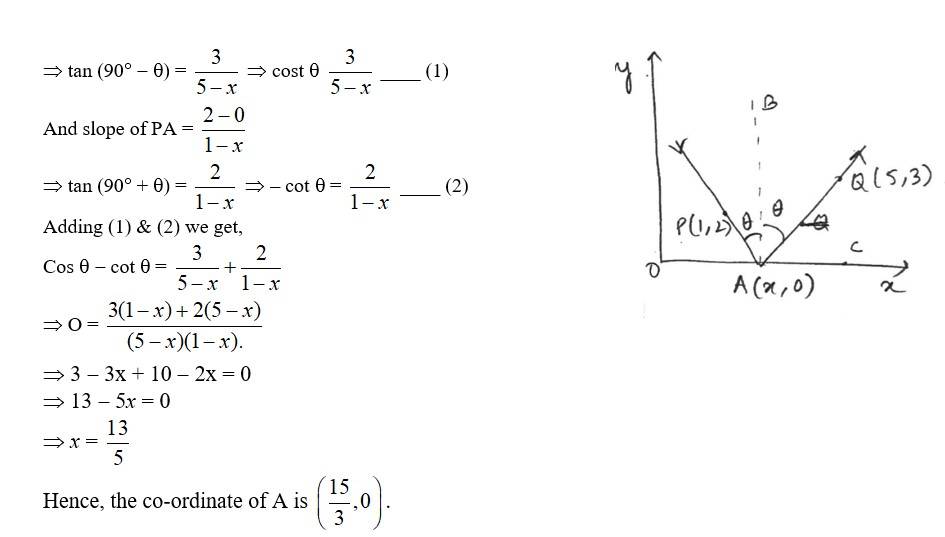
7. Find the slope of the line, which makes an angle of 30°with the positive direction of y-axis measured anticlockwise.
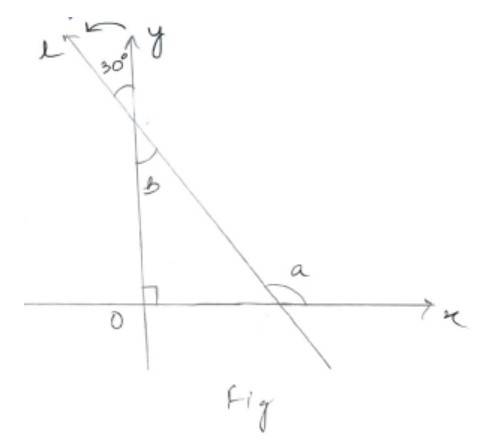
7.
Let l be the line making 30° with y-axis as shown in figure. Then,
Angle a = + 90° (Sum of exterior angle of a triangle)
( vertically opposite angle)
So, slope of line l = tan a
= m = tan 120°
= tan (180° – 60°)
= –tan 60°
75. Prove that the product of the lengths of the perpendiculars drawn from the points ![]()
Kindly go through the solution
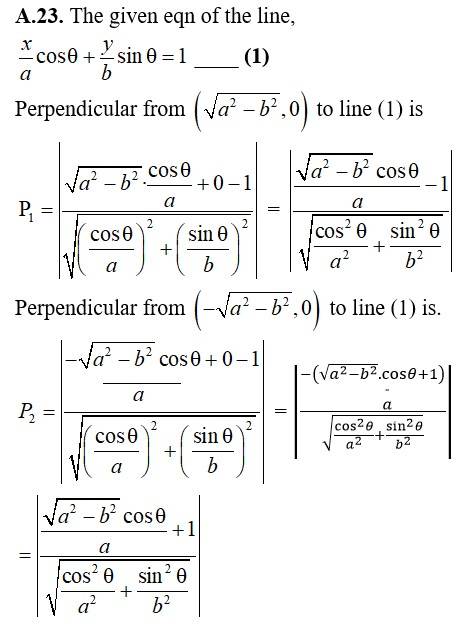
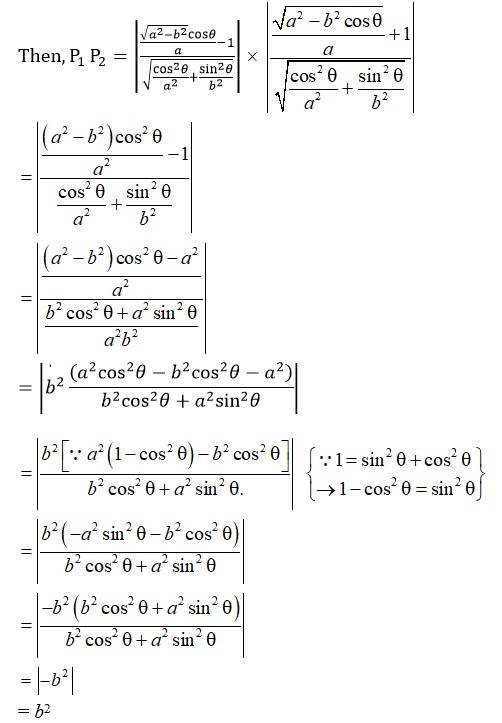
76. A person standing at the junction (crossing) of two straight paths represented by the equations 2x – 3y + 4 = 0 and 3x + 4y – 5 = 0 wants to reach the path whose equation is 6x – 7y + 8 = 0 in the least time. Find equation of the path that he should follow.
76.
If point P be the junction between the lines
2x – 3y + 4 = 0 ______ (1)
3x + 4y – 5 = 0 ______ (2)
Solving (1) and (2) using 3 × (1) – 2 × (2) we get,
6x – 9y + 12 – (6x + 8y – 10) = 0
–17y + 22 = 0
y =
And 2x = 3y– 4
=> 2x = 3 × – 4
x = – 2 = =
Hence, the co-ordinate of the junction is P
The eqn of the path to be reach is
6x – 7y + 8 = 0 _____ (3)
Then, least distance will be perpendicular path.
So, slope of ⊥ path =
Hence eqn of shortest/least distance path from P is
119x + 102y – 125 = 0
5. Find the slope of a line, which passes through the origin, and the mid-point of the line segment joining the points P (0, – 4) and B (8, 0).
5.
Let 0 (0, 0) be the origin and A be the mid-point of line joining P (0, –4) and B (8, 0)
Then, co-ordinate of A =
Slope of OA, m =
45. Find angles between the lines √3x + y = 1and x + √3y = 1.
Kindly go through the solution
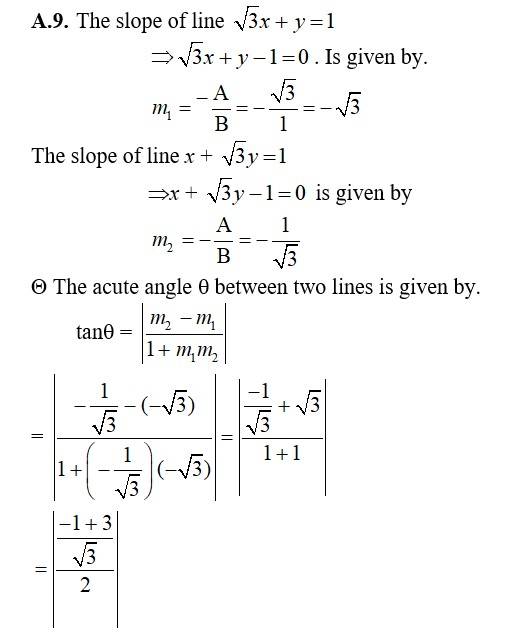
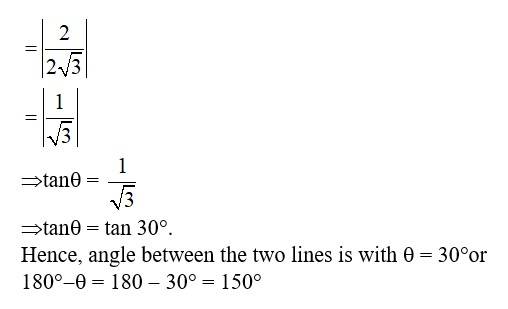
6. Without using the Pythagoras theorem, show that the points (4, 4), (3, 5) and (–1, –1) are the vertices of a right angled triangle.
6.
. Let the given point be A (4, 4), B (3, 5) and C (–1, –1)
Then, slope of AB, m1 =
Slope of AC, m2 =
And slope of BC, m3 =
As m1 – m2 = –1 × 1 = –1
We conclude that AB and AC are perpendicular to each other.
Hence, ABC is a right-angle triangle right-angled at A
8. Find the value of x for which the points (x, – 1), (2,1) and (4, 5) are collinear.
8. Let P (x, –1), Q (2, 1) and R (4, 5) be the collinear points. Then,
Slope of PQ = Slope of QR
9. Without using distance formula, show that points (– 2, – 1), (4, 0), (3, 3) and (–3, 2) are the vertices of a parallelogram.
9.
Let A (–2, –1), B (4, 0), C (3, 3) and D (–3, 2) be the given points.
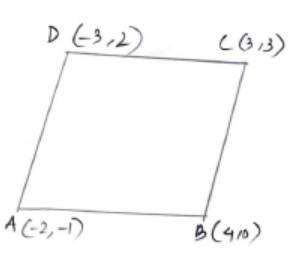

Slope of DC =
As slope of AB = slope of DC
We conclude that AB | | DC.
Similarly, slope of BC =
Slope of AD =
As slope of BC = slope of AD we conclude that BC | | AD.
Hence, as the pair of opposite sides of ABCD are parallel we can conclude that the given points are the vertices of a parallelogram.
11. The slope of a line is double of the slope of another line. If tangent of the angle between them is , find the slopes of the lines.
11.
Let the two slopes be m and 2m. And if θ is the angle between the two lines.
Case I. When
Case II. When
Hence,
The possible slopes of the two lines (m, 2m) are (1, 2), and
63. Find the value of p so that the three lines 3x + y – 2 = 0, px + 2 y – 3 = 0 and 2x – y – 3 = 0 may intersect at one point.
63. The given eqn of the lines are.
3x + y - 2 = 0 _____ (1)
Px + 2y - 3 = 0 ______ (2)
2x - y - 3 = 0 _____ (3)
Point of intersection of (1) and (3) is given by,
(3x + y - 2) + (2x - y - 3) = 0
=> 5x - 5 = 0
=> x =
=> x = 1
So, y = 2 - 3x = 2 -3 (1) = 2 - 3 = 1.
i e, (x, y) = (1, -1).
As the three lines interests at a single point, (1, -1) should line on line (2)
i e, P * 1 + 2 * (-1)- 3 = 0
P - 2 - 3 = 0
P = 5
66. Find the equation of the line passing through the point of intersection of the lines 4x + 7y – 3 = 0 and 2x – 3y + 1 = 0 that has equal intercepts on the axes.
66. The given eqn of the line is.
4x + 7y – 3 = 0 _____ (1)
2x – 3y + 1 = 0 _______ (2)
Solving (1) and (2) using eqn (1) 2 x eqn (2) we get,
(4x + 7y – 3) 2 [ (2x – 3y + 1)] = 0
4x + 7y – 3 – 4x + 6y – 2 = 0
13y = 5
y =
And 2x – 3 + 1 = 0
2x = – 1 =
Point of intersection of (1) and (2) is
Since, the line passing through has equal intercept say c then it is of the form
x + y = c
c =
the read eqn of line is x + y =
13x + 13y – 6 = 0
70. Find the direction in which a straight line must be drawn through the point (–1, 2) so that its point of intersection with the line x + y = 4 may be at a distance of 3 units from this point.
70. The given equation of the line is
l1: x + y = 4
Let P (x0, y0) be the point of intersect of l1 and the line to be drawn.
Then, x0 + y0 = 4 ⇒ y0 = 4? x
Given, distance between P (x0, y0) and Q (? 1, 2) is 3
ie, ![]()
⇒ (x0 + 1)2 + (y? 2)2= 9
⇒x20+1+ 2x0 + (4? x? 2)2 = 9
⇒ x20+ 2x0 + 1 + (2? x0 )2 = 9
⇒x20+ 2x0 + 1 + 4 + x20 ? 4x0 ?9 = 0
⇒ 2 x20 ?2x0 ? 4 = 0
x20 ? x0 ? 2 = 0
x20 + x0 ? 2x0 ? 2 = 0
x0 (x +1)? 2 (x0 +1) = 0
(x0 +1) (x0 ? 2) = 0
x0 = 2 and x0 =? 1
When, x0 = 2, y0 = 4 ?2 = 2.
and when x0 =? 1, y0 = y? (?1) =5.
The points of interaction of line l1which are at distance 3 unit from Q (? 1, 2) are P1 (2,2) and P2 (? 1, 5)
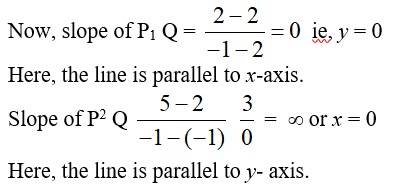
71. Find the image of the point (3, 8) with respect to the line x +3y = 7 assuming the line to be a plane mirror.
71.
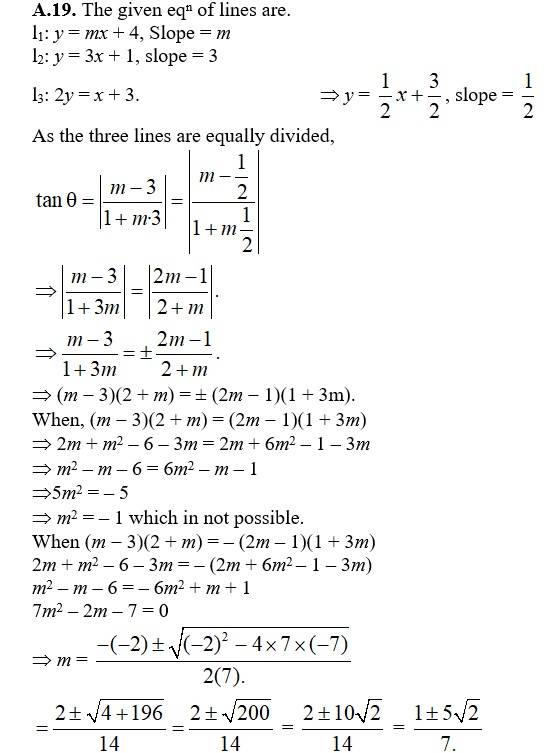
62. Find the area of the triangle formed by the lines y – x = 0, x + y = 0 and x – k = 0.
62.
The given eqn of the lines are
y - x = 0 _____ (1)
x + y = 0 ______ (2)
x - k = 0 ______ (3)
The point of intersection of (1) and (2) is given by
(y - x) - (x + y) = 0
⇒ y - x -x -y = 0
y = 0 and x = 0
ie, (0, 0)
The point of intersection of (2) and (3) is given by
(x + y) – (x – k) = 0
y + k = 0
y = –k and x = k
i.e, (k, –k)
The point of intersection of (3) and (1) is given by
x = k
and y = k
ie, (k, k).
Hence area of triangle whose vertex are (0, 0), (k, –k)
and (k, k) is
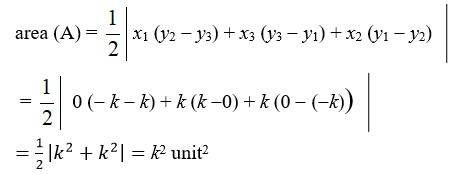
59. Find perpendicular distance from the origin to the line joining the points (cosθ, sin θ) and (cos ϕ, sin ϕ).
Kindly go through the solution
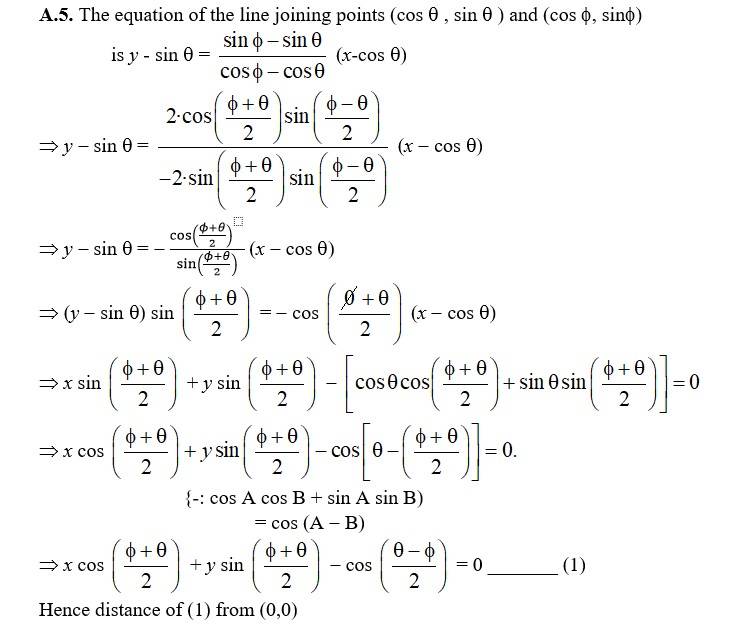

24. Find the equation of the line passing through (–3, 5) and perpendicular to the line through the points (2, 5) and (–3, 6).
24.
Slope of line passing through points (2, 5) and (–3, 6) is
So, slope of line perpendicular to line through (2, 5) and (–3, 6) is
Equation of line with slope 5 and passing through (–3, 5) is
41. Find the points on the x-axis, whose distances from the line are 4 units.
Kindly go through the solution
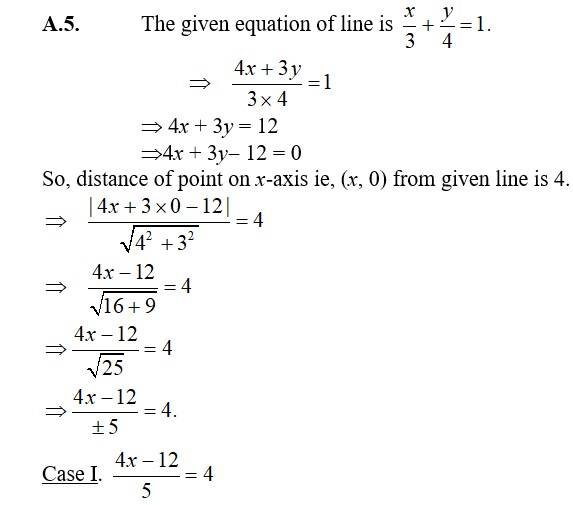
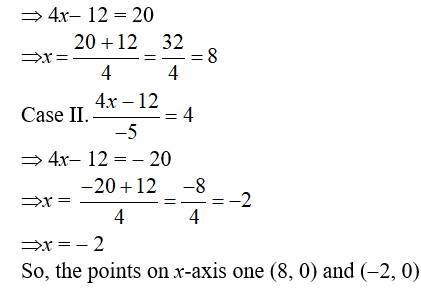
25. A line perpendicular to the line segment joining the points (1, 0) and (2, 3) divides it in the ratio 1: n. Find the equation of the line.
25.
Let P(1, 0) and Q(2, 3) be the given points. Then, slope of line joining PQ,
If A divides PQ with ratio 1:n, co-ordinate of A is
So, slope of line perpendicular to line joining points P and Q
Hence, equation of line passing through point A and (perpendicular to line) joining points P and Q is given by
61. Find the equation of a line drawn perpendicular to the line through the point, where it meets the y-axis.
61. The given Eqn of the line is = 1 ______ (1)
so, Slope of line = -
The line ⊥ to line (1) say l2 has
Slope of l2 =
Let P (0, y) be the point of on y-axis where it is cut by the line (1)
Then,
y = 6
i.e, the point P has co-ordinate (0, 6)
Eqn of line ⊥ to and cuts y-axis at P (0,6) is
y – 6 = (x – 0)
3y – 18 = 2x
2x – 3y + 18 = 0
64. If three lines whose equations are y = m1x + c1, y = m2x + c2 and y = m3x + c3 are concurrent, then show that m1(c2 – c3) + m2 (c3 – c1) + m3 (c1 – c2) = 0.
64. The given eqn of the three lines are
y = m1 x + c1 ______ (1)
y = m2 x + c2 ______ (2)
y = m3 x + c3 ______ (3)
The point of intersection of (2) and (3) is given by.
y - y = (m2x + c2) - (m3 x + c3)
(m2 - m3) x = c3 - c2
Hence, y =
As the three lines are concurrent, the point of intersection of (2) and (3) lies on line (1) also
i e,
m1 (c2 - c3) - c1 (m2 - m3) + m2 c3 - m3 c2 = 0
m1 (c2 - c3) - m2 c1 + m3 c1 + m2 c3 - m3 c2 = 0
m1 (c2 - c3) + m2 (c3 - c1) + m3 (c1 - c2) = 0
43. Find equation of the line parallel to the line 3x − 4y + 2 = 0 and passing throughthe point (–2, 3).
43.
The slope of the line 3x - 4y + 2 = 0 is,
So, slope of line parallel to 3x - 4y + 2 = 0 is also m=
Hence, this parallel line passes through ( -2, 3) we can write,
3 (x + 2) = 4 (y - 3)
3x + 6 = 4y - 12
3x - 4y + 6 + 12 = 0.
3x - 4y + 18 = 0. Which is the required equation of line.
51. The perpendicular from the origin to the line y = mx + c meets it at the point (–1, 2). Find the values of m and c.
51.
Let 0 (o, o) be the origin and P (-1, 2) be the given point on the line y = mx + c.
Then, slope of OP, =
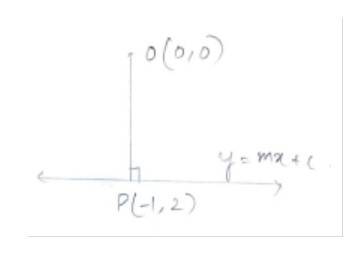
Slope of OP = -2
As the line y = mx + c is ⊥ to OP we can write
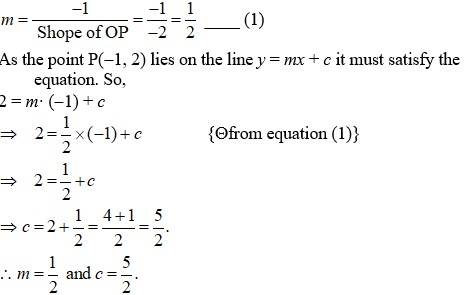
60. Find the equation of the line parallel to y-axis and drawn through the point of intersection of the lines x – 7y + 5 = 0 and 3x + y = 0
60. The given eqn of lines are
x - 7y + 5 = 0 ______ (1) ⇒ x = 7y - 5
and 3x + y = 0 _________ (2)
Solution (1) and (2) we get,
3 [7y – 5] + y = 0 .
⇒ 21y - 15 + y = 0
⇒ 22y = 15
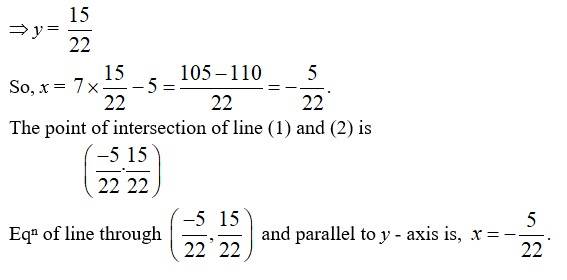
12. A line passes through (x1, y1) and (h, k). If slope of the line is m, show that k – y1 = m (h – x1).
12.
Let the line l passes through points (x1, y1) and (h, x)
Then slope of l,
Hence, proved
26. Find the equation of a line that cuts off equal intercepts on the coordinate axes and passes through the point (2, 3).
26.
Let the line cuts x and y axis at intercept c. Then a = b = c
Then by intercept form the equation of line is
Since equation (1) passes through point (2, 3).
Hence 2 + 3 = c
So, substituting value of c in equation (1) we get
27. Find equation of the line passing through the point (2, 2) and cutting off intercepts on the axes whose sum is 9.
Let a and b be the intercepts on x and y-axis
Then a + b = 9
Using intercept form equation of line with a and b intercepts are
As point (2, 2) passes the line having equation of form equation (2) we can write as
So, a = 3, 6
Case I
When a = 3, b = 9 – 3 = 6. Then the equation of line is
Case II
When a = 6, b = 9 – 6 = 3. Then equation of line is
Hence, equation of line is 2x + y – 6 or x + 2y – 6 = 0
36. By using the concept of equation of a line, prove that the three points (3, 0), (– 2, – 2) and (8, 2) are collinear.
36.
Let the given points be A (3, 0), B (–2, –2) and C (8, 2). Then by two point form we can write equation of line passing point A (3, 0) and B (–2, –2) as
If the three points A, B and C are co-linear, C will also lieonm the line formed by AB or satisfies equation (1).
Hence, putting x = 8 and y = 2 we have
L.H.S. = 2 × 8 – 5 × 2 – 6
= 16 – 10 – 6
= 0 = R.H.S.
The given three points are collinear.
44. Find equation of the line perpendicular to the line x – 7y + 5 = 0 and havingx intercept 3.
44.
The slope of line x- 7y + 5 = 0 is

So, equation of line with slope m2 and having x-intercept 3 is
y = m (x-d), d = x- intercept
⇒y = - 7 (x- 3)
⇒y = - 7x + 21
⇒ 7x + y- 21 = 0.
47. Prove that the line through the point (x1, y1) and parallel to the line Ax + By + C = 0 is A (x –x1) + B (y – y1) = 0.
47.
The slope of line 4x + by + c = 0 is
m = -A/B
As the required line is parallel to the line Ax + by + c = 0
They have the same slope ie, m = -A/B
So, equation of line with slope m and passing through (x1, y1)
is given by point-slope from as,


⇒ - A (x-x1) B (y -y1)
⇒ A (x-x1) + B (y-y1)= 0.
Hence proved.
48. Two lines passing through the point (2, 3) intersects each other at an angle of 60o. If slope of one line is 2, find equation of the other line.
48.
Given, slope of line 1, m1 = 2.
Let m2 be the slope of line 2.
If θ is the angle between the two lines then we can write,
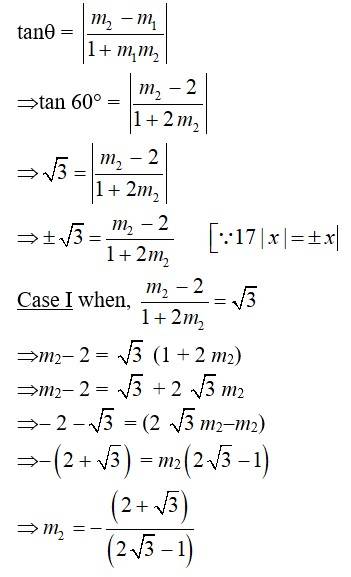
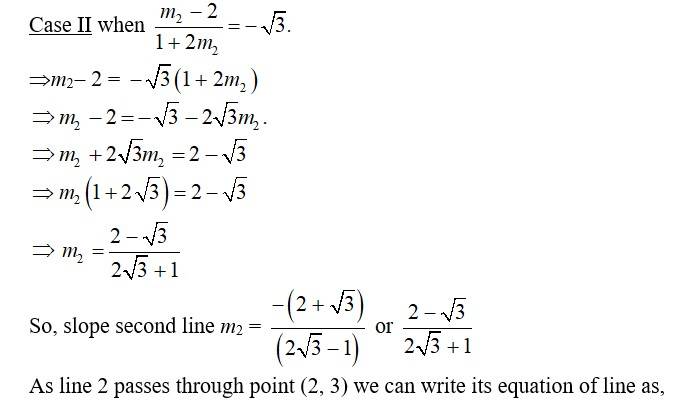
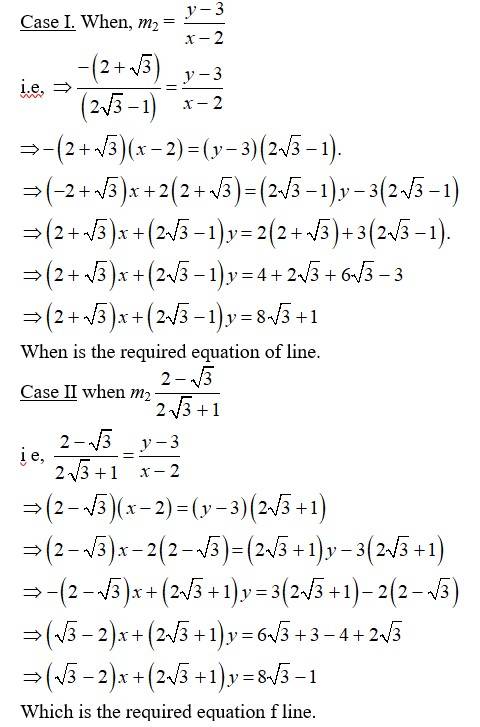
55. Find the values of k for which the line (k–3) x – (4 – k2) y + k2 –7k + 6 = 0 is
(a) Parallel to the x-axis,
(b) Parallel to the y-axis,
(c) Passing through the origin.
55. We have (k - 3) x - (4 - k2) y + k2 - 7 y + 6 = 0.
(i) When the line is parall to x-axis, all x coefficient = 0. then,
(k - 3)x - (4 -k2)y + k2 - 7y + 6 = 0 x.x - a x y where a = constant
Equating the co-efficient,
K – 3 = 0
=> k = 3
(ii) When the line is parallel to y-axis all y co-efficient = 0 then
- (4 -k)2 = 0
=> – 4 + x2 = 0
k2 = 4
k = ± 2.
(iii) When the line pares through origin, (0, 0) need satisfy the given eqn then,
k2 - 7k + 6 = 0
k2 - k – 6k + 6 = 0
k (k- 1) - 6 (k - 1) = 0
(k = 1) (k - 6) = 0
k = 1 and k = 6
65. Find the equation of the lines through the point (3, 2) which make an angle of 45o with the line x – 2y = 3.
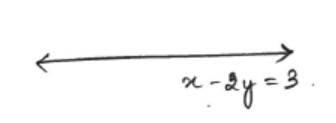
65. x – 2y = 3
y =
Slope of line (1) is
Let the line through P (3, 2) have slope m
Then, angle between the line =
When,
The eqn of line through (3, 2) is
y – 2 = 3 (x – 3) 3x – y – 7 = 0.
When
The equation of line through (3,2) is,
y – 2 =
x + 3y – 9 = 0
67. Show that the equation of the line passing through the origin and making an angle ø with the line
67. The given eqn of line is.
l1 : y = mx + c.
Slope of l1 = m
Let m? be the slope of line passing through origin (0, 0) and making angle θ with l1
Thus, (y 0) = m? (x 0)
y = m? x
m? =
And tanθ =
When, tanθ =
tanθ + m? m tanθ = m’ - m
m + tanθ = m? - m?m tanθ
m' =
When tan θ =
tan θ + m? m tanθ = -m? + m
m' =
Hence combining the two we get,
18. Passing through (2 , 2√3) and inclined with the x-axis at an angle of 75o.
18.
The slope of the line is, m = tan 75° – tan (45° + 30°)
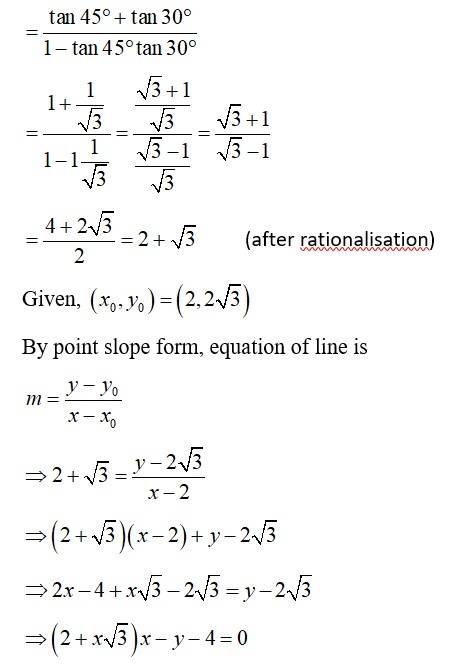
68. In what ratio, the line joining (–1, 1) and (5, 7) is divided by the line x + y = 4?
68. The given eqn of line is
l1: x + y = 4
Let R divides the line joining two points P (?1,1) and Q (5,7) in ratio k:1. Then,
Co-ordinate of R = (
As l1 divides line joining PQ, then R lies on l1
i e,
5k ?1 + 7k + 1= 4 (k + 1)
12k = 4k + 4
8k = 4
k =
The ratio in which x + y = 4 divides line joining (?1,1) ad (5,7) is
15. Write the equations for the x-and y-axes.
Exercise 9.2
15.
For any points on x-axis the y-co-ordinate or the ordinate is always 0. Hence, the x-axis have the equation y = 0.
Similarly for xy points on y-axis the x-co-ordinate or the abscissa is always 0. Hence, the y-axis have the equation x = 0.
19. Intersecting the x-axis at a distance of 3 units to the left of origin with slope –2.
19.
Given m = –2
x-intercept, d = –3
Using slope intercept form, equation of line is
y = m (x – d)
21. Passing through the points (–1, 1) and (2, – 4).
21
.Here (x1, y1) = (–1, 1) and (x2, y2) = (2, –4)
Using two point form, equation of line is
35. Point R (h, k) divides a line segment between the axes in the ratio 1: 2. Find equation of the line.
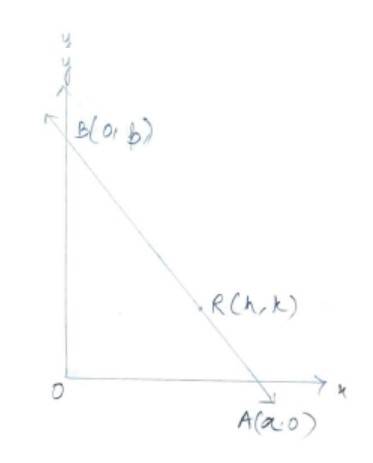
35. Equation of line with intercept form is
As R (h, x) divides line segment joining point A (a, 0) and B (0, b) in the ratio 1 : 2 we can write,
So,
Hence, putting value of a and b in equation (1) we get,
16. Passing through the point (– 4, 3) with slope
2.
Given,
By point slope form equation of line is
42. Find the distance between parallel lines
(i) 15x + 8y – 34 = 0 and 15x + 8y + 31 = 0 (ii) l (x + y) + p = 0 and l (x + y) – r = 0.
42.
(i) Given, equation of lines are
15x + 8y- 34 = 0
15x + 8y + 31 = 0
So, c1 = 34 and c2 = 31, A = 15 and B = 8
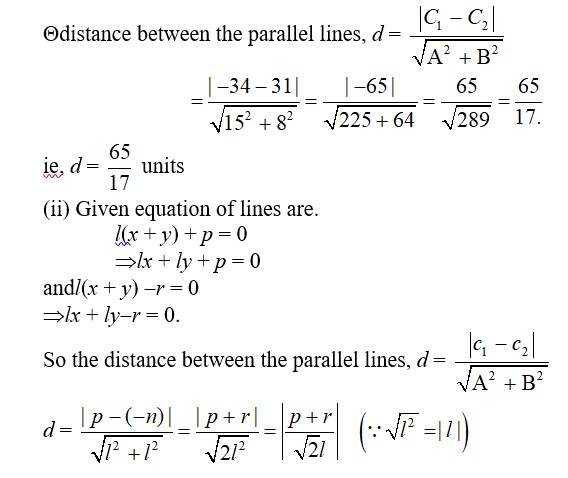
53. In the triangle ABC with vertices A (2, 3), B (4, –1) and C (1, 2), find the equation and length of altitude from the vertex A.
53. Let P be the point on the BC dropped from vertex A.
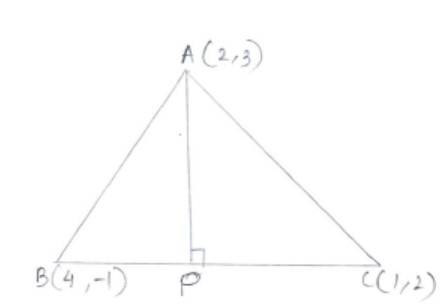
Slope of BC
=
As A P
Slope of AP=
Using slope-point form the equation of AP is,
The equation of line segment through B(4, -1) and C(1, 2) is.
So, A=1, B=1 and C=
Hence, length of AP=length of
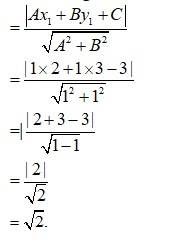
56. Find the values of q and p, if the equation x cosØ + y sinØ = p is the normal form of the line √3
56. The given equation of the line is 3x + y + 2 = 0
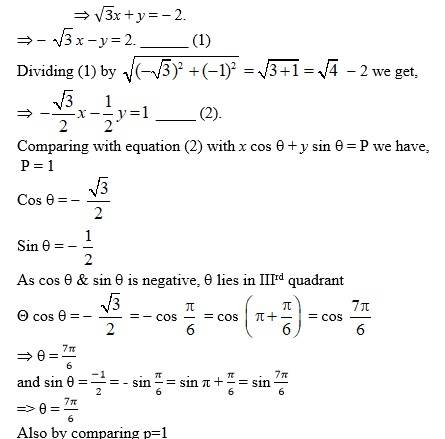
57. Find the equations of the lines, which cut-off intercepts on the axes whose sum and product are 1 and – 6, respectively.
57. Let a and b be the x & y intercept. Then,
Given, a + b = 1. ______ (2) b = 1 -a _____ (3)
and ab = -6 _____ (4)
Putting eqn (B) in (iii) we get a
a (1- a) = - 6
a - a2 = - 6
a2 - a - 6 = 0
a2 + 2a - 3a - 6 = 0
a (a + 2) - 3 (a + 2) = 0
(a + 2) (a -3) = 0
(a + 2) (a -3) = 0.
a = 3 or a = -2.
When a = 3, b = 1- a = 1 - 3 = - 2
When a = - 2, b = 1 - (-2) = 1 + 2 = 3
So, (a, b) = (3, -2) and (-2, 3)
Hence, eqn (1) becomes,
2x – 3y = 6 and 2y - 3x = 6
Gives the read eqn of lines
69. Find the distance of the line 4x + 7y + 5 = 0 from the point (1, 2) along the line 2x – y = 0.
69.
The given eqn of the lines are.
4x + 7y + 5 = 0______ (1)
2x - y = 0 ______ (2)
Solving (1) and (2) we get,
4 x + 7 (2 x)+5 = 0
4x +14 x + 5= 0
x =
and y = 2x =
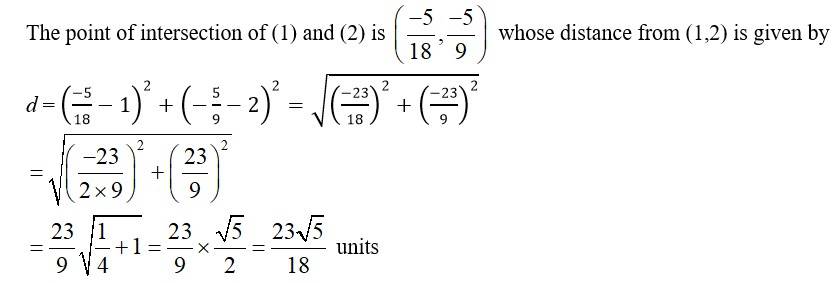
72. If sum of the perpendicular distances of a variable point P (x, y) from the lines x + y – 5 = 0 and 3x – 2y +7 = 0 is always 10. Show that P must move on a line.
72. The given eqn of the lines are.
x + y ? 5 = 0 _______ (1)
3x ? 2y + 7 = 0 ______ (2)
Given, sum of perpendicular distance of P (x, y) from the two lines is always 10 .
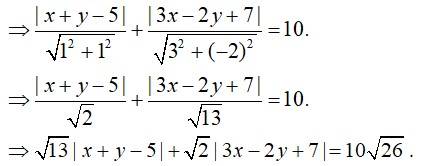
The above eqn can be expressed as a linear combination Ax + By + C = 0 where A, B & C are constants representing a straight line
P (x, y) mover on a line.
Q1. Draw a quadrilateral in the Cartesian plane, whose vertices are (– 4, 5), (0, 7), (5, – 5) and (– 4, –2). Also, find its area.
Exercise 9.1
1. Let the given points be A(–4, 5), B(0, 7), C(5, –5) and D(–4, –2).
Then quadrilated ABCD can be plotted on the graph by joining the points A, B, C and D.
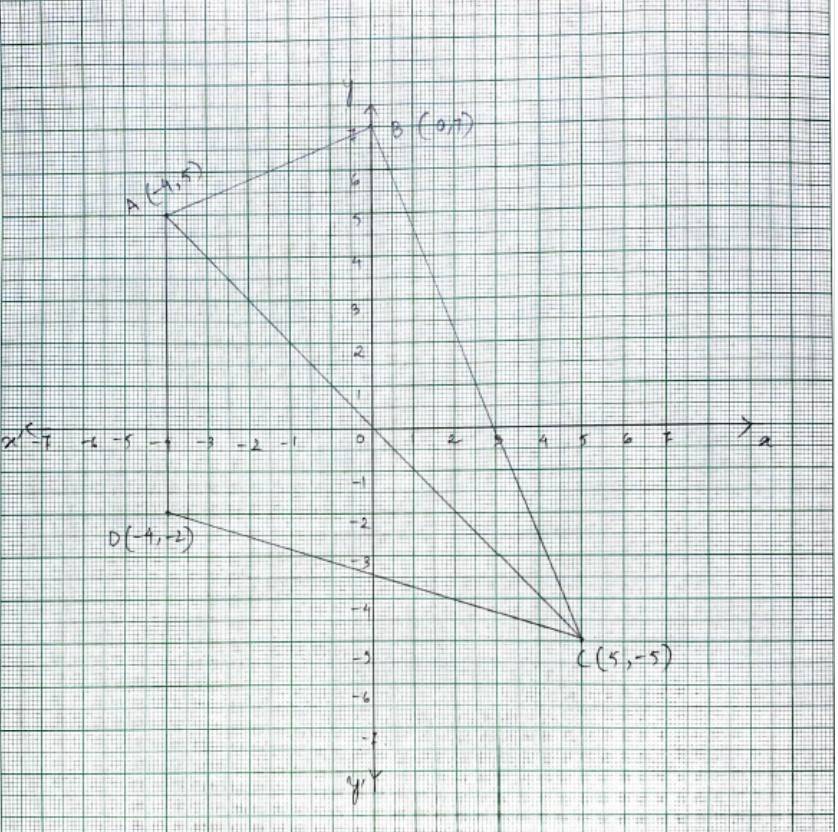
We connect diagonal AC such that
area (ABCD) = (ΔABC) + (ΔADC)
Now,
Similarly,
Hence, area (ABCD) =
2. The base of an equilateral triangle with side 2a lies along the y-axis such that the mid-point of the base is at the origin. Find vertices of the triangle.
2. Let ABC be the equilateral triangle of side 2a and 0 be the origin. Then
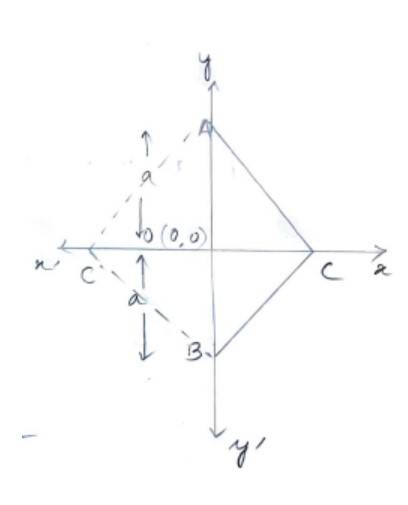
AB = BC = AC = 2a
O is the mid-point of AB we have AO = a
BO = a
We know that A and B lies on y-axis so they have co-ordinate of the form (0, y).
Hence, co-ordinate of A is (0, a) and that of B is (0, –a)
Since OC, bisects AB at right angle, by Pythagoras theorem,
AC2= OA2 + OC2

And as C we on x-axis it has co-ordinate of the form (x, 0)

3. Find the distance between P (x1, y1) and Q (x2, y2) when : (i) PQ is parallel to the y-axis, (ii) PQ is parallel to the x-axis.
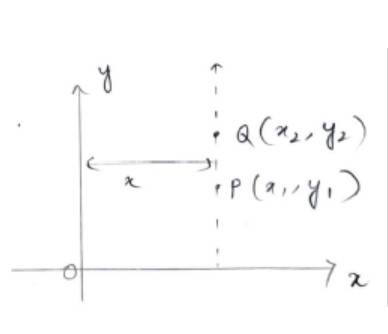
3.

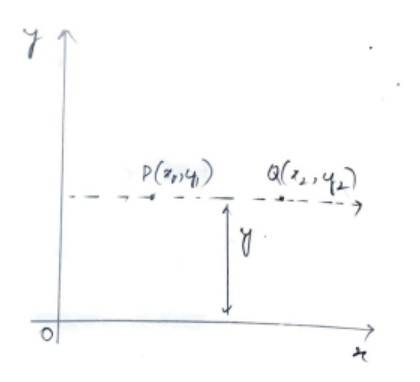
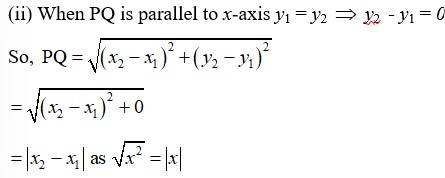
4. Find a point on the x-axis, which is equidistant from the points (7, 6) and (3, 4).
4.
Let A (x, 0) be the point on x-axis when is equidistant from P (7, 6) and Q (3, 4)
Then, PA = QA

Squaring both sides, we get,
14. Consider the following population and year graph (Fig 9.10), find the slope of the line AB and using it, find what will be the population in the year 2010 ?
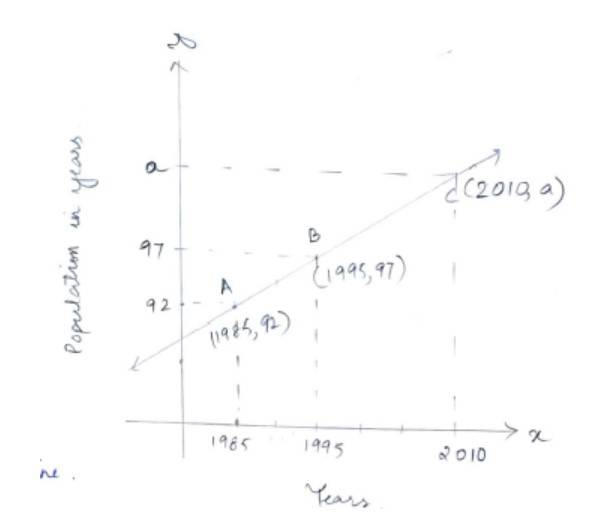
14.
From figure,
Slope of AB =
As, A, B and C lie on same line
Slope of AB = Slope of BC
Hence, population in 2010 will be 104.5 crores.
31. The owner of a milk store finds that, he can sell 980 litres of milk each week at Rs 14/litre and 1220 litres of milk each week at Rs 16/litre. Assuming a linear relationship between selling price and demand, how many litres could he sell weekly at Rs 17/litre?
31.
Assuming the price per litre say P in x-axis and the corresponding demand say D in y-axis, we have two point (14, 980) and (16, 1220) in xy plane. Then the points (P, D) will satisfy the equation.

Which is the required relation
Where P = 17, we have
D = 120 × 17 – 700
D = 1340
Hence, the owner can sell 1340 litres of milk weekly at 17/litre
13. If three points (h, 0), (a, b) and (0, k) lie on a line, show that
13.
Since the three points say P (h, o), Q (a, b) and R (o, k) lie on a line.
Slope of PQ = slope of QR
Dividing both sides by kh we get,
17. Passing through (0, 0) with slope m.
17.
Given slope = m and
By point slope from, equation of line is
22. Perpendicular distance from the origin is 5 units and the angle made by the perpendicular with the positive x-axis is 300.
23.
Given P = 5 and W = 30°
Using normal form, equation of line is
x cos W + y sin W = P
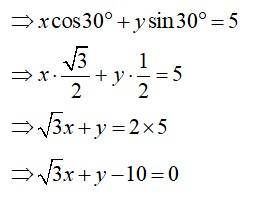
23. The vertices of ΔPQR are P (2, 1), Q (–2, 3) and R (4, 5). Find equation of the median through the vertex R.
23.
Let RM be the median draw from vertex R so that M is the mid-point of line segment PQ. Then,

= (0, 2)
So equation of line passing through R (4, 5) and M (0, 2) is
29. The perpendicular from the origin to a line meets it at the point (–2, 9), find the equation of the line.
29.
The slope of line passing through (0, 0) and (–2, 9) is
The line perpendicular to the line having slope m1 will have the slope
So, the equation of line with slope m2 and passing
30. The length L (in centimetre) of a copper rod is a linear function of its Celsius temperature C. In an experiment, if L = 124.942 when C = 20 and L= 125.134 when C = 110, express L in terms of C.
30.
Assuming L along y-axis and C along x-axis, we have two points (124.942, 20) and (125.134, 110) in xy-plane. By two-point form, the point L and C satisfies the equation.
y-124.942=
32. P (a, b) is the mid-point of a line segment between axes. Show that equation of the line is
32.
Since P (a, b) is the mid-point of the line segment say AB with points A (0, y) and B (x, 0) we can write,
So, the equation of line with x and y intercept 2a and 2b using intercept form is
Hence, proved
33. The owner of a milk store finds that, he can sell 980 litres of milk each week at Rs 14/litre and 1220 litres of milk each week at Rs 16/litre. Assuming a linear relationship between selling price and demand, how many litres could he sell weekly at Rs 17/litre?
33. Assuming the price per litre say P in x-axis and the corresponding demand say D in y-axis, we have two point (14, 980) and (16, 1220) in xy plane. Then the points (P, D) will satisfy the equation.

Which is the required relation
Where P = 17, we have
D = 120 × 17 – 700
D = 1340
Hence, the owner can sell 1340 litres of milk weekly at? 17/litre
34. P (a, b) is the mid-point of a line segment between axes. Show that equation of the line is
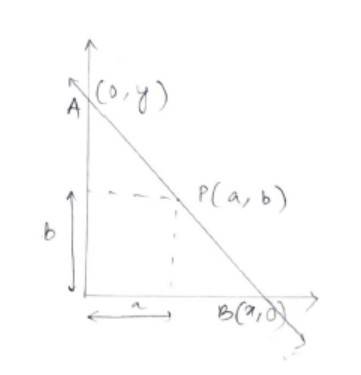
34.
Since P (a, b) is the mid-point of the line segment say AB with points A (0, y) and B (x, 0) we can write,
So, the equation of line with x and y intercept 2a and 2b using intercept form is
Hence, proved
37. Reduce the following equations into slope - intercept form and find their slopes and the y - intercepts.
(i) x + 7y = 0, (ii) 6x + 3y – 5 = 0, (iii) y = 0.
Exercise 9.3
37. (i) Given, x + 7y = 0.
7y = -x
y =
Comparing the above equation with y = mx + c we get, slope, m = -
(ii) Given, 6x + 3y - 5 = 0
3y = -6x + 5
y = -
Comparing the above equation with y = mx + c we get, slope, m = -2 and
(iii) Given, y = 0
y = 0xx + 0
Comparing the above equation with y = mx + c we get, Slope, m = 0 and c = 0, y-intercept.
38. Reduce the following equations into intercept form and find their intercepts onthe axes.
(i) 3x + 2y – 12 = 0, (ii) 4x – 3y = 6, (iii) 3y + 2 = 0.
38. (i) Given, 3x + 2y 12 = 0.
3x + 2y = 12
Dividing both sides by 12 we get,
Comparing the above equation with
(ii) Given, 4x - 3y = 6
Dividing the both sides by 6.
Comparing above equation by
(iii) Given, 3y + 2 = 0.
3y = -2
As the equation of line is of form y = constant, it is parallel to x-axis and has no x-intercept.
y-intercept = -
39. Reduce the following equations into normal form. Find their perpendicular distances from the origin and angle between perpendicular and the positive x-axis.
(i) x – √3y + 8 = 0, (ii) y – 2 = 0, (iii) x – y = 4.
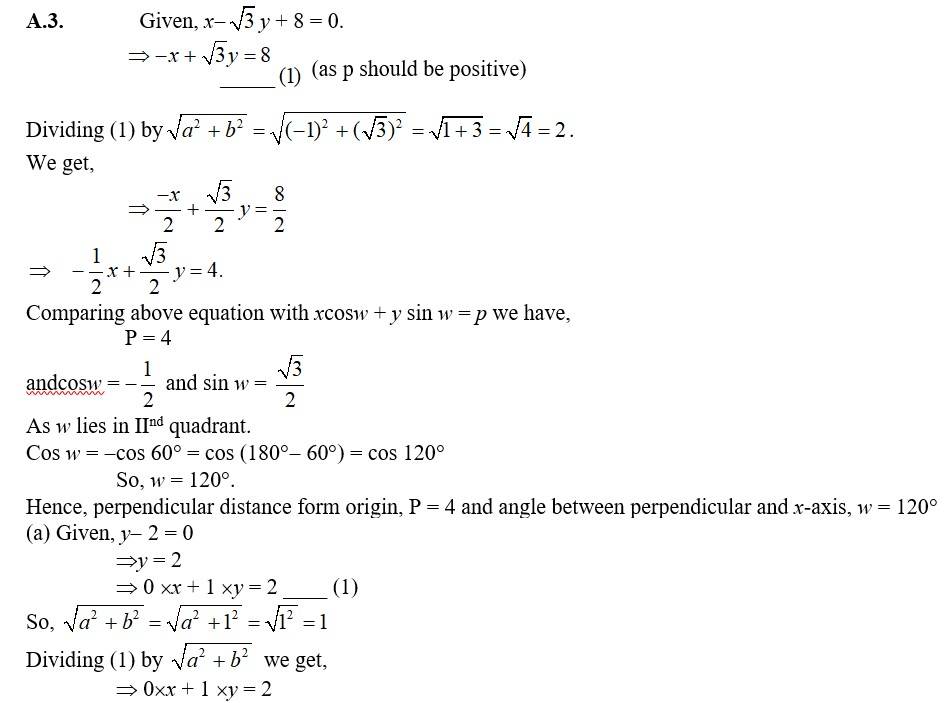
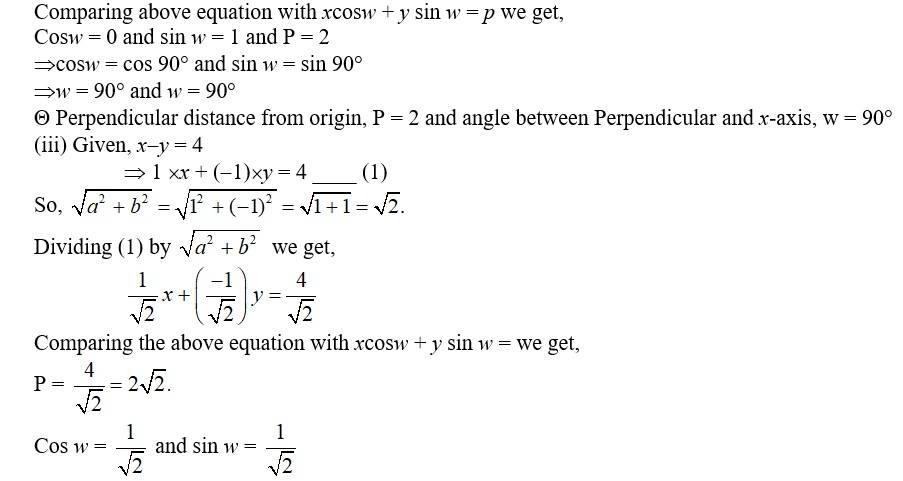
As w lies in IVth quadrant
Cos w = cos 45° and sin w = - sin 45°
= cos (360°- 45°) = sin (360°- 45°)
= cos 315° = sin 315°
So, w = 315°
40. Find the distance of the point (–1, 1) from the line 12(x + 6) = 5(y – 2).
40.
The given equation of the line is.
12 (x + 6) = 5 (y- 2)
⇒ 12x + 72 = 5y- 9
⇒ 12x- 5y + 72 + 9 = 0
⇒ 12x- 5y + 82 = 0
The perpendicular distance of point (-1, 1) from the line is given by
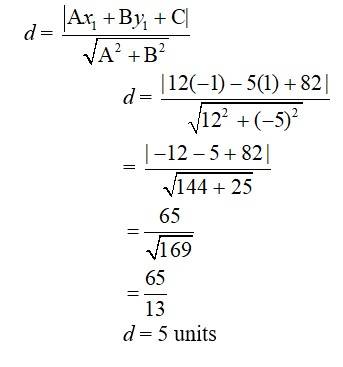
46. The line through the points (h, 3) and (4, 1) intersects the line 7x − 9y −19 = 0 at right angle. Find the value of h.
46. Slope of line 1 (passing) through (h. 3) and (4, 1) is
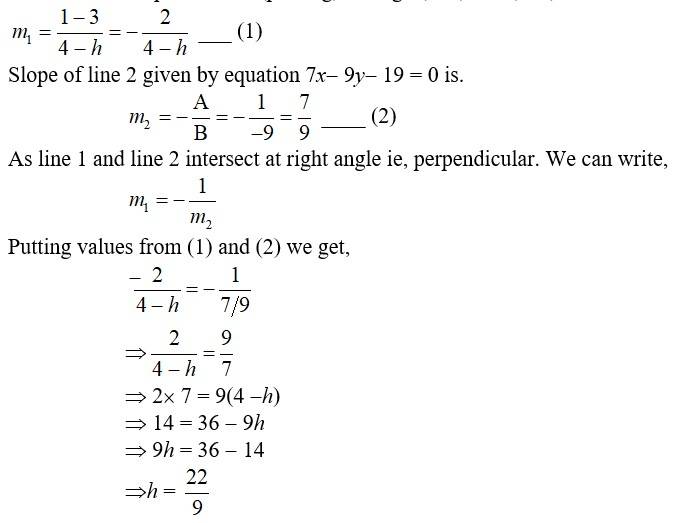
49. Find the equation of the right bisector of the line segment joining the points (3, 4)and (–1, 2).
49.
Let P(3, 9) and Q (-1, 2) be the point. Let M bisects PQ at M so,
Co-ordinate of M =
Now, slope of AB, m =
As the bisects AB perpendicular it has slope
2x + y - 5 = 0
50. Find the coordinates of the foot of perpendicular from the point (–1, 3) to theline 3x – 4y – 16 = 0.
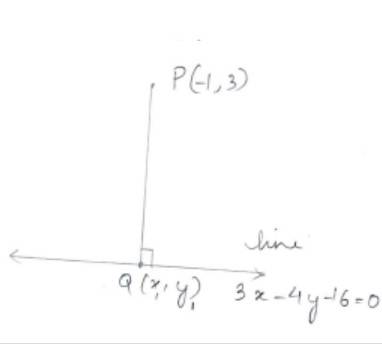
50. Let P(-1, 3) be the given point and Q(x, y,) be the Co-ordinate of the foot of perpendicular
So, slope of line 3x - 4y - 16 = 0 is
And slope of line segment joining P(-1, 3) and Q(x, y,) is
As they are perpendicular we can write as,
(y1-3)3 = - 4(x1 +1)
3y1- 9 = - 4x1- 4.
4x1 + 3y1-9 + 4 = 0
4x1 + 3y1-5 = 0 ___ (1)
As point Q(x1, y1) lies on the line 3x- 4y - 16 = 0 it must satisfy the equation hence,
3x1- 4y1- 16 = 0 ____ (2)
Now, multiplying equation (1) by 4 and equation (2) by 3 and adding then,
4× (4x1 + 3y1- 5) + 3(3x1- 4y1- 16) = 0.
16x1 + 12y1- 20 + 9x1- 12y1- 48 = 0
25x1 = 48 + 20
Putting value of x1 in equation (1) we get,
4× 68 + 25× 3y1 = 25 ×5.
25× 3y1 = 125 - 272
52. If p and q are the lengths of perpendiculars from the origin to the lines x cos q − ysinq = k cos2 and x sec q + y cosec q = k, respectively, provethat p2 + 4q2 = k2.
52. The given equation lines are.
line 1: xcosθ-y sin θcos 2θ
⇒ xcosθ-y sin θ - kcos 2θ = 0
The perpendicular distance from origin (0,0) to line 1 is
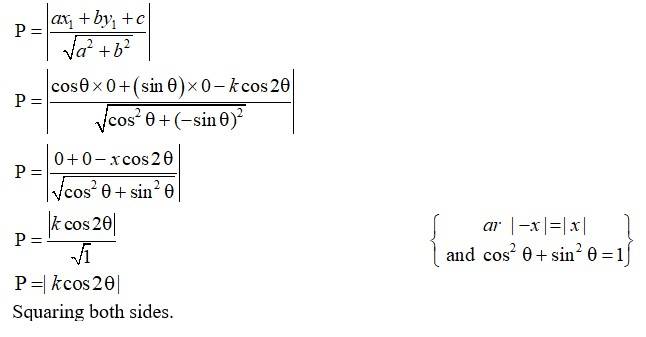
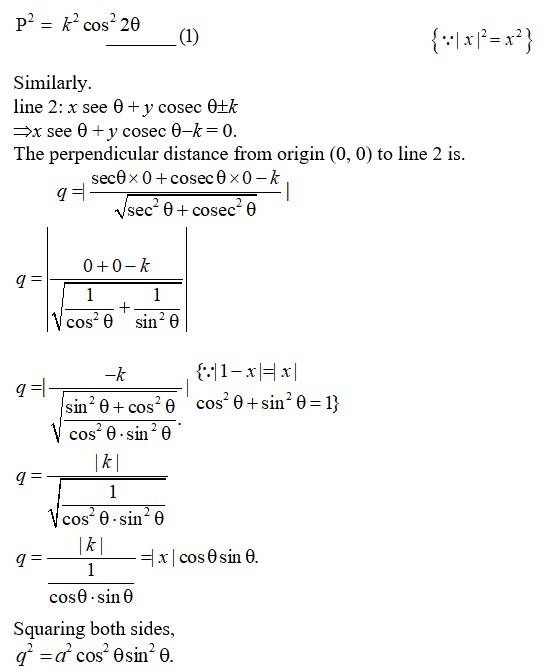
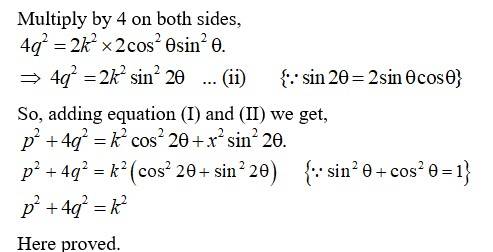
54. If p is the length of perpendicular from the origin to the line whose intercepts on the axes are a and b, then show that
54. The equation of line whose intercept on axes are a and b is given by,
Multiplying both sides by ab we get,
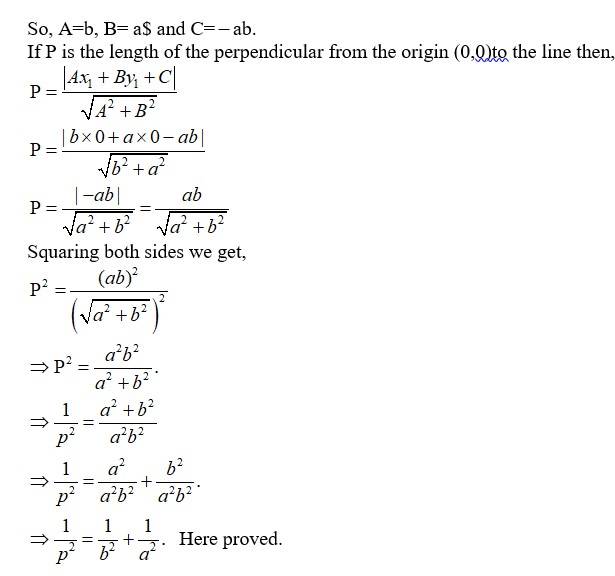
58. What are the points on the y-axis whose distance from the line
58. Let (0, y) be the point on y-axis which is at a distance 4 unit from the line
Then, the line
4x + 3y = 12.
4x + 3y - 12 = 0
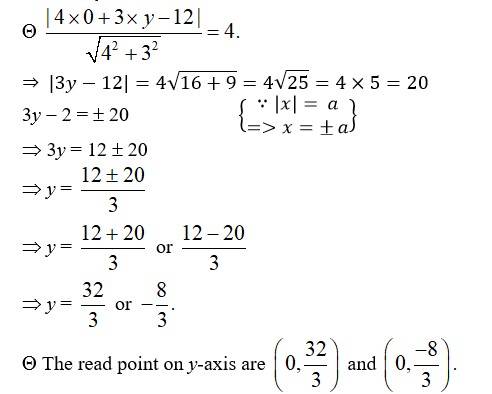
28. Find equation of the line through the point (0, 2) making an angle
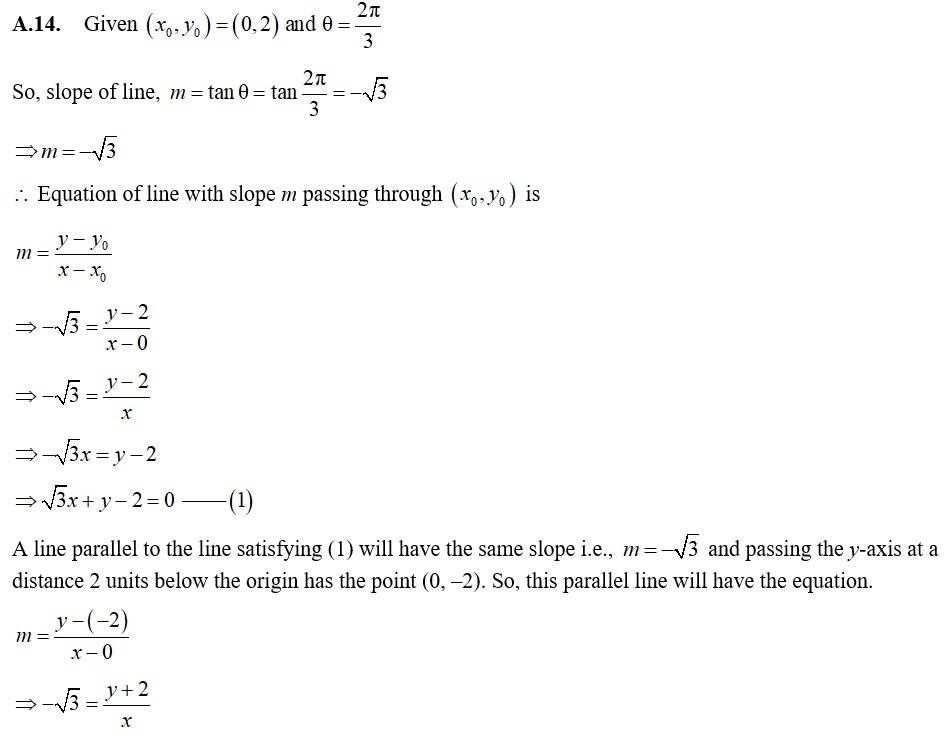

Explore exams which ask questions on Maths Ncert Solutions class 11th
Select your preferred stream
Maths Ncert Solutions class 11th Exam
Student Forum
Other Similar chapters for you
- Binomial Theorem
- Probability
- Statistics
- Mathematical Reasoning
- Limits and Derivatives
- Introduction to Three Dimensional Geometry
- Conic Sections
- Straight Lines
- Sequences and Series
- NCERT Maths 11th
- Permutations and Combinations
- Linear Inequalities
- Complex Numbers and Quadratic Equations
- Principle of Mathematical Induction
- Trigonometric Functions
Popular Courses After 12th
Exams accepted
CA FoundationExams accepted
ICSI ExamExams accepted
BHU UET | GLAET | GD Goenka TestBachelor of Business Administration & Bachelor of Law
Exams accepted
CLAT | LSAT India | AIBEExams accepted
IPMAT | NMIMS - NPAT | SET
Exams accepted
BHU UET | KUK Entrance Exam | JMI Entrance ExamBachelor of Design in Animation (BDes)
Exams accepted
UCEED | NIFT Entrance Exam | NID Entrance ExamBA LLB (Bachelor of Arts + Bachelor of Laws)
Exams accepted
CLAT | AILET | LSAT IndiaBachelor of Journalism & Mass Communication (BJMC)
Exams accepted
LUACMAT | SRMHCAT | GD Goenka Test
